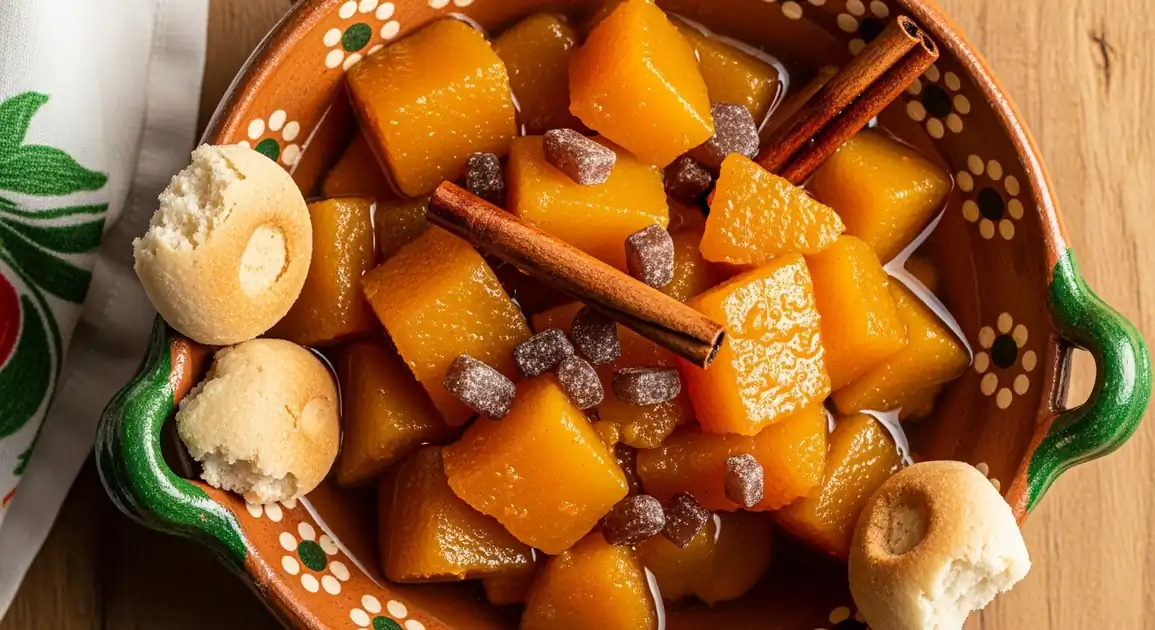Chilacayota
Chilacayote en Dulce

Description
Chilacayota is found throughout Mexico, particularly in central and southern regions, though preparation styles vary by region. It's especially popular during fall harvest season and Day of the Dead celebrations when newly harvested chilacayote squash is abundant. In Mexico City, Puebla, and Oaxaca, it's a common seasonal treat found in markets and during festivals.
Dietary Information
Serving information
Serving style
Typically served in small bowls, sometimes with sweet bread on the side for dipping in the syrup. Often eaten with a spoon, with the syrup considered an essential part of the experience.
Quick facts
Market vendors typically sell from 9 AM - 5 PM. Festival vendors often operate from 12 PM - 9 PM, with peak availability during seasonal celebrations.
Safety Tips
What to Look For
-
Clean, covered containers for storage
Chilacayota should be stored in clean glass or food-grade containers with lids to protect from contaminants and insects.
-
Clear, amber-colored syrup
Quality chilacayota has a clear, amber-colored syrup without cloudiness, which indicates proper preparation and storage.
-
Visible cinnamon sticks or whole spices
The presence of whole spices rather than just ground spices often indicates more traditional, careful preparation.
-
Regular stirring or rotation of product
Vendors who occasionally stir or rotate their chilacayota ensure even distribution of syrup and prevent drying out of exposed pieces.
What to avoid
-
Fermentation bubbles or alcoholic smell
Bubbling or a fermented/alcoholic smell indicates that the chilacayota has begun to ferment and should not be consumed.
-
Cloudy or thickened syrup
Extremely cloudy or overly thickened syrup may indicate bacterial growth or excessive age.
-
Mold on the surface
Any visible mold on the chilacayota or its syrup means it should be avoided completely.
-
Crystallized sugar throughout
While some sugar crystallization is normal, excessive crystallization throughout indicates the dessert is too old or has been improperly stored.
Price information
Price range
Budget tips
- Markets generally offer better prices (25-40 MXN per serving) than tourist-oriented restaurants.
- Buying from local neighborhood vendors rather than in tourist areas can save 20-30%.
- Purchasing during peak season (October-November) ensures better quality at lower prices.
Value indicators
- Clear, rich syrup with visible spices.
- Generous portion size with substantial squash pieces.
- Homemade or artisanal preparation rather than mass-produced.
- Fresh preparation rather than overly aged product.
Where to Find This Dish
Traditional Markets
Found in dedicated dulce (sweet) sections of mercados públicos.
Central de Abasto, Mercados Municipales
Morning, Afternoon
Festival Areas
Common during religious celebrations and public festivals.
Church Plazas, Public Squares
Afternoon, Evening
Tourist Zones
Sold in modified, sometimes less traditional versions in areas frequented by visitors.
Pedestrian Walking Streets, Craft Markets
Afternoon
Vendor Tips
- Ask when it was prepared ('¿Cuándo se preparó?') to ensure freshness.
- Look for vendors who prepare in small batches rather than massive quantities.
- Traditional clay pots often indicate more authentic preparation methods.
How to Order
Regional Variations
-
Chilacayota with Guava
(Chilacayota con Guayaba)
Chunks of guava are added to the traditional recipe, adding a fruity, slightly tart dimension to the sweet dessert.
-
Spiced Chilacayota
(Chilacayota Especiada)
Enhanced with additional spices like cloves, star anise, or orange peel for a more complex flavor profile.
-
Chilacayota with Tejocote
(Chilacayota con Tejocote)
Mexican hawthorn (tejocote) is added to the syrup, creating a sweet-tart combination popular during holiday seasons.
-
Dried Fruit Chilacayota
(Chilacayota con Frutas Secas)
Incorporates dried fruits like prunes, raisins, or dried apricots, which plump up in the syrup and add textural contrast.
Cultural context
History
Chilacayota has pre-Hispanic origins, as the chilacayote squash was cultivated by indigenous peoples in Mexico for thousands of years. After the Spanish introduction of cane sugar and cinnamon, preservation methods evolved to create this sweet delicacy. The tradition of preparing chilacayota became particularly associated with harvest season and Day of the Dead celebrations, when preserved fruits were practical offerings that could last throughout the ceremonial period. In Oaxaca, it has retained its cultural significance as both a daily sweet treat and an important ritual food.
Local significance
Represents the tradition of preserving seasonal produce and is strongly associated with harvest celebrations and Day of the Dead offerings.
Eating customs
- Often accompanied by pan de muerto or pan de yema (egg bread) during Day of the Dead.
- The syrup is considered as important as the squash pieces themselves.
- Traditionally eaten at room temperature rather than cold.